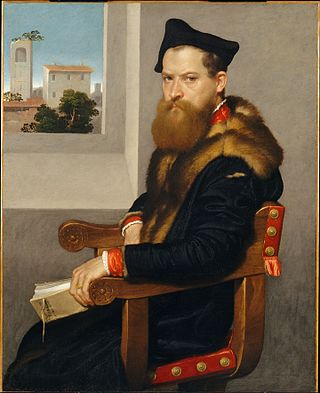
Giovanni Battista Moroni was an Italian painter of the Mannerism. He also is called Giambattista Moroni. Best known for his elegantly realistic portraits of the local nobility and clergy, he is considered one of the great portrait painters of the Cinquecento.
Andrea Solari (1460–1524) was an Italian Renaissance painter of the Milanese school. He was initially named Andre del Gobbo, but more confusingly as Andrea del Bartolo a name shared with two other Italian painters, the 14th-century Siennese Andrea di Bartolo, and the 15th-century Florentine Andrea di Bartolo.

Fra’ Galgario, born Giuseppe Vittore Ghislandi, and also called Fra’ Vittore del Galgario, was an Italian painter, mainly active in Bergamo as a portraitist during the Rococo or late-Baroque period.

Cristoforo Moretti was a Lombard painter of the quattrocento who worked in a late International Gothic style very similar to that of Michelino da Besozzo’s last period. Few of the unsigned works later attributed to him are attributed with perfect certainty.

Via Manzoni is a busy and fashionable street in the Italian city of Milan which leads from the Piazza della Scala north-west towards Piazza Cavour. Notable buildings include the Museo Poldi Pezzoli, the elegant Grand Hotel et de Milan, which was the place of Giuseppe Verdi’s death in 1901, and several fine palaces. Via Manzoni was originally called Corsia del Giardino before the crossroad with Via Monte Napoleone and Corso di Porta Nuova up until Piazza Cavour.

Profile Portrait of a Young Lady is a 1465 half-length portrait, made with oil-based paint and tempera on a poplar panel, usually attributed to Antonio del Pollaiuolo, although the owning museum, the Gemäldegalerie in Berlin, now describes this work as by his brother Piero del Pollaiuolo, and as one of its most famous paintings, and as one of the most famous portraits of women from the early Italian Renaissance.

The Tailor is an oil on canvas painting by Italian painter Giovanni Battista Moroni, from 1565-1570. It is a portrait of a member of the Marinoni family, who has been traditionally taken to be a tailor practising his art during the work day. The painting is held in the National Gallery, in London.

The Poldi Pezzoli Madonna or Madonna with the Sleeping Christ Child is a tempera on canvas painting by Andrea Mantegna, dating to around 1490-1500, after the painter's trip to Rome. It was bought from Giovanni Morelli's collection by Gian Giacomo Poldi Pezzoli shortly after the 1850s and is now in the Museo Poldi Pezzoli in Milan. It was restored in 1863 by Giuseppe Molteni, who added the varnish which has now yellowed.

Pietà is a tempera-on-panel painting executed c.1455–1460 by the Italian Renaissance artist Giovanni Bellini, now in the Museo Poldi Pezzoli in Milan. One of his earliest works, it is the prototype for his long series of other Pietas such as Pietà (Bergamo).

The Portrait of Bartolomeo Bonghi is an oil on canvas portrait by Italian artist Giovanni Battista Moroni, created in 1553. It is held at the Metropolitan Museum of Art, in New York. It depicts Bartolomeo Bonghi, a 16th-century Italian legal scholar. The portrait presents its subject as he was in life; a man of wealth and status. The buildings seen in the top left-hand corner of the painting identify the site of the portrait's sitting as Bergamo in Lombardy.

The Museo Adriano Bernareggi, also called the Museo Diocesano Bernareggi is an gallery of sacred art and objects housed in a former aristocratic palace, the Palazzo Bassi-Rathgeb, located on Via Pignolo #76 in Bergamo, Italy. The museum is presently managed by the Fondazione Adriano Bernareggi in conjunction with the Università degli Studi di Bergamo, and displays eclectic works of art from the 15th-century to present, often paired, and derived mainly from the Bernareggi family, as well as the Diocese of Bergamo.

Portrait of a Young Woman is a mixed-technique painting on panel of c. 1470–1472, variously attributed to Piero del Pollaiuolo or his brother Antonio. It is now in Milan in the Museo Poldi Pezzoli, which uses the painting as its symbol.
Simone Facchinetti is an Italian art historian.

Mystic Marriage of Saint Catherine or Mystic Betrothal of Saint Catherine is a 1567-1570 oil on panel painting by Giovanni Battista Moroni, produced for the side-altar of Catherine of Alexandria in the church of San Bartolomeo, parish church of Almenno San Bartolomeo, where it still hangs. It is signed at lower right IO:BAP.MORONUS.P. The church had been begun in 1520 through the will of Giorgio Rota, but work lapsed until restarting in 1562. The painting draws on the composition of Moretti's 1539 Rovelli Altarpiece.

Count Guglielmo Lochis was an Italian nobleman, politician, art collector and art connoisseur.

The Chess Game is a painting of c. 1530 by Giulio Campi, a Renaissance painter from Cremona. Since 1970, it has been in the Museo Civico d'Arte Antica in Turin.

Self-Portrait Aged 71 is an 1862 oil-on-canvas painting by the Italian artist Francesco Hayez. The Uffizi had been requesting a self-portrait from him since 1858 via Andrea Appiani's daughter-in-law Giuseppina Appiani Strigelli and it finally arrived in 1863. It is still in the Uffizi's Vasari Corridor.

Portrait of a Courtesan or Portrait of a Woman is a c. 1520 oil on canvas painting by Palma Vecchio, now in the Museo Poldi Pezzoli in Milan.

The Portrait of Alessandro Vittoria is an oil on canvas painting created by Italian painter Giovanni Battista Moroni, in 1551–1552. It is held at the Kunsthistorisches Museum, in Vienna.

The Portrait of a Man Holding a Letter, also known as The Lawyer, is an oil on canvas painting by Italian painter Giovanni Battista Moroni, from 1570-1572. It is held at the National Gallery, in London. It is considered one of the most representative paintings of the artist's maturity.


















